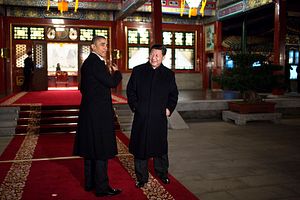Speaking alongside U.S. President Barack Obama in the White House Rose Garden in September 2015, Chinese President Xi Jinping offered certain assurances about China’s then-heavily scrutinized island-building activity in the South China Sea — specifically in the Spratly Islands, where Beijing has reclaimed land and built up seven artificial islands.
“Relevant construction activities that China are undertaking in the Nansha (Spratly) Islands do not target or impact any country, and China does not intend to pursue militarization,” Xi remarked at the time.
The statement was of great interest to South China Sea watchers, who saw it has a pledge of sorts. Of course, at the time, it was already plain that China’s construction activities, which included, among other things, the addition of airstrips able to handle any aircraft within the People’s Liberation Army Air Force’s inventory on Subi, Mischief, and Fiery Cross Reefs, wasn’t entirely non-military.
Per Xi and the Chinese Foreign Ministry, however, these dual-use type facilities offered a certain degree of useful plausible deniability as to China’s intentions in the South China Sea. Until now, that is.
Earlier this week, satellite imagery released by a U.S. think tank shows, for the first time, evidence of military point-defense capabilities on various China-controlled features in the Spratly Islands. The Asia Maritime Transparency Initiative at the Center for Strategic and International Studies found that “China appears to have built significant point-defense capabilities, in the form of large anti-aircraft guns and probable close-in weapons systems (CIWS), at each of its outposts in the Spratly Islands.”
I recommend heading over to AMTI’s website to view the satellite imagery for yourself, which contains convincing evidence of fortified anti-aircraft gun emplacements that cannot but have a military application in the South China Sea.
Not only does the development mark China’s most visible and obvious break with Xi’s assurance not to “militarize” the Spratlys, but it also probably marks the end of China’s Foreign Ministry couching the construction and reclamation activities in terms of benign civilian and disaster relief applications.
In fact, recent Chinese messaging around these facilities is not evasive or duplicitous, with the Chinese Ministry of Defense frankly acknowledging that “it is legitimate for China to deploy necessary defense facilities in the Nansha islands.”
In a statement posted to its website, acknowledging that an “American think tank recently said that China was suspected of deploying weapons and equipment on the islands and reefs in the Nansha Islands,” the Chinese Defense Ministry adds such deployments are “necessary military facilities.”
China’s definition of militarization in the South China Sea has been somewhat obtuse to date, with Beijing considering its own activities as complementary to civilian applications while seeing U.S. activities like freedom of navigation operations and patrols as active attempts by Washington to militarize the area. The Chinese Defense Ministry’s shift in language now suggests that Beijing recognizes that its own actions constitute militarization in the South China Sea.
China’s final intentions in the South China Sea remain unclear, but analysts expect that Beijing could intend to declare an air defense identification zone over the area to reinforce its existing claims. Washington’s fear is that China could use its presence between the Spratly Islands and the Paracel Islands to restrict freedom of navigation, particularly for lawful naval patrols if not for civilian commerce. In July 2016, China’s capacious “nine-dash line” claim to most of the South China Sea was found to have no basis in international law, according to a five-judge tribunal at the Permanent Court of Arbitration in The Hague.
If the Chinese artificial islands are fully militarized, with PLAAF fighter-bomber regiments flying from the three Spratly airstrips, China could conceivably project power into the Western Pacific, the Timor Sea north of Australia, and the Andaman Sea in the Indian Ocean.

































